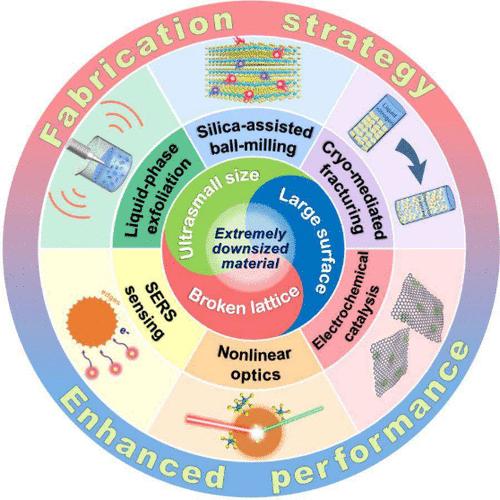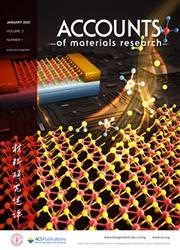Extremely Downsized Materials: Ball-Milling-Enabled Universal Production and Size-Reduction-Induced Performance Enhancement
IF 14.7
Q1 CHEMISTRY, MULTIDISCIPLINARY
引用次数: 0
Abstract
Extremely downsized (including quantum-sized and subnanometer-sized) materials with sizes between atoms and nanoparticles have attracted tremendous attention thanks to their unique structures and exotic physical and chemical properties. Such unusual materials will induce a range of enhanced performances compared with their nanoscale and bulk counterparts, which can be beneficial to driving advancements of materials science as well as nanoscience and nanotechnology. However, it is quite challenging to prepare extremely downsized materials due to their ultrasmall sizes and ultralarge surfaces. Up to now, a variety of strategies have been explored for the preparation of extremely downsized materials, among which the basic categories are top-down and bottom-up methods. The former generally tailors bulk materials into downsized nanomaterials by physical routes, while the latter usually involves chemical (solution) processes to synthesize nanomaterials. During past decades, most efforts have been devoted to bottom-up methods for the synthesis of extremely downsized materials (e.g., colloidal quantum dots, sub-nanometer-sized materials, clusters, and supermolecules). Meanwhile, the production of extremely downsized materials through top-down methods is far from satisfactory, limited by their low manufacturing capacities and relatively expensive facilities. Note that nanomaterials produced by top-down physical methods exhibit entirely exposed surface/edge lattices, while the surface/edge lattices synthesized by bottom-up chemical methods are protected by ligands, making the surface/edge effects greatly obscured. Undoubtedly, exploiting a robust strategy to produce extremely downsized materials with maximized exposed lattices by all-physical top-down methods is required and desired. Our group has been focusing on all-physical production and extreme performances of extremely downsized materials since 2015. We have developed a universal and scalable strategy (i.e., the combination of silica-assisted ball-milling and sonication-assisted solvent exfoliation and treatment) for the all-physical production of quantum-sized materials. A series of quantum-sized materials with intrinsic characteristics have been produced, pushing forward the establishment of a complete database/library. Recently, two-stage silica-assisted ball-milling has been employed to realize the universal production of sub-nanometer-sized materials with entirely exposed and broken intrinsic lattices, suggesting that the top-down fabrication limit has reached the subnanometer (single-lattice) scale. Enhanced performances are demonstrated in both quantum-sized and sub-nanometer-sized materials because of their numerous broken lattices on surfaces/edges.

超小型材料:滚珠铣实现的通用生产和尺寸缩小带来的性能提升
尺寸介于原子和纳米粒子之间的超小型(包括量子尺寸和亚纳米尺寸)材料因其独特的结构和奇异的物理和化学性质而备受关注。与纳米级和大块材料相比,这种非同寻常的材料将带来一系列更强的性能,有利于推动材料科学、纳米科学和纳米技术的发展。然而,由于超小尺寸和超大表面,制备超小型材料具有相当大的挑战性。迄今为止,制备超小型材料的方法多种多样,基本分为自上而下法和自下而上法。前者一般是通过物理方法将块状材料定制成缩小的纳米材料,而后者通常是通过化学(溶液)工艺合成纳米材料。在过去的几十年中,大多数人都致力于采用自下而上的方法合成超小型材料(如胶体量子点、亚纳米级材料、团簇和超分子)。与此同时,通过自上而下的方法生产超小型材料的效果却不尽如人意,这主要受限于其较低的制造能力和相对昂贵的设备。需要注意的是,通过自上而下的物理方法制备的纳米材料呈现出完全暴露的表面/边缘晶格,而通过自下而上的化学方法合成的表面/边缘晶格受到配体的保护,表面/边缘效应被大大掩盖。毫无疑问,利用全物理自上而下方法制备具有最大化暴露晶格的超小型材料是必要的,也是理想的。自 2015 年以来,我们的研究小组一直专注于全物理生产和极端性能的极端缩小材料。我们开发了一种通用的、可扩展的量子尺寸材料全物理制备策略(即二氧化硅辅助球磨和超声辅助溶剂剥离和处理相结合)。目前已制备出一系列具有固有特性的量子尺寸材料,推动了完整数据库/资料库的建立。最近,利用两级二氧化硅辅助球磨技术,实现了本征晶格完全暴露和破碎的亚纳米尺寸材料的普遍制备,表明自上而下的制备极限已达到亚纳米(单晶格)尺度。由于量子尺寸和亚纳米尺寸材料的表面/边缘存在大量破碎晶格,因此它们的性能都得到了增强。
本文章由计算机程序翻译,如有差异,请以英文原文为准。
求助全文
约1分钟内获得全文
求助全文

 求助内容:
求助内容: 应助结果提醒方式:
应助结果提醒方式:


